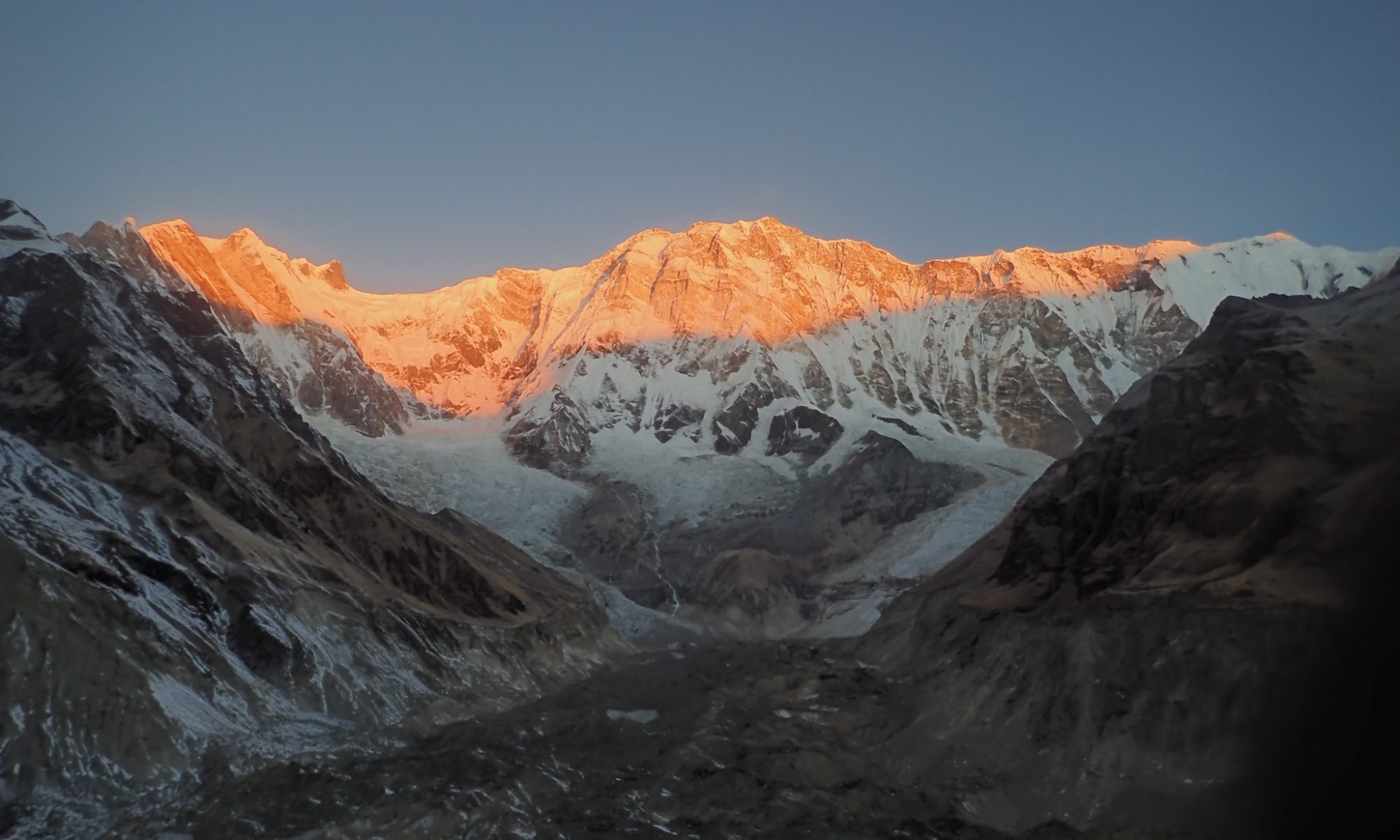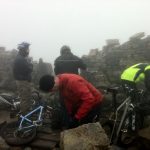I won a competition last week to ride with Brian Lopes at Dalby, during the World Cup XC race there. 6 of us ended up riding on the day with Brian, on a short stretch of the red route, with a few stops to chat and bug him about his career, bike, and life in general. It was a great day out, and Brian was really awesome, welcoming, and chatty. At one point, he was behind me on a technical singletrack section; I don’t think I’ve ever felt such pressure to ride well, than when I had Lopes on my tail.
Mountain biking up (and down) Ben Nevis
On Tuesday 10 May 2011, a bunch of mates and I biked up Ben Nevis, and back down again. We’d been planning it for quite some time, as we’d previously mountain biked Snowdon, and it got us thinking about the next level.
We knew Nevis would be a much bigger challenge, especially with bad weather, but given we’d had terrible weather when we did Snowdon, we figured ourselves fairly well prepared for it. Planned as part of our mountain biking Scotland 2011 8-day riding trip, we sandwiched the Nevis ascent between a couple of days biking Glentress and Innerleithen, and the rest of the trip afterwards that included Fort William DH and XC, Laggan, Golspie, and Balblair.
Snowdon’s summit is at 1085 metres above sea level, and took us 2.5 hours to climb on mountain bikes, up the Ranger’s path (which starts around 50m above sea level). Ben Nevis is 1344 metres above sea level.
We stayed at the Ben Nevis bunkhouse, which is conveniently sited right at the start of the trail up the mountain. The night before, we prepared well, by having a big dinner at the Ben Nevis Inn, and sinking quite a few local beers. We also discussed safety, made sure we each had maps, knew the route, and had the right kit, including waterproofs, layers, walkie-talkies, first aid kits, whistles, torches, spares, tools, tubes, food, drink, and something to celebrate with at the summit…
The route is known as the mountain track – and used to be known as the tourist path but was changed in order to better reflect the seriousness of the endeavour.
On the day, the weather was poor, but not terrible. Some wind, and some rain, but not torrential, and not too cold, so we kitted up and set off around 11am. Just a few pedal strokes from the inn, we found ourselves pushing and carrying our bikes, which was to be the style for the next few hours. The first section, up to the lake at 570m, is stepped and rocky, with rocks worn smooth by years of walking boots passing by. This was pretty tough stuff to carry bikes up, as the steps are just that bit too big for a wheel to roll up. Those of us with heavy full-suspension bikes were struggling a bit compared to the guys with light hardtails. We passed one poor chap who looked in a pretty poor condition, and Joe kindly provided him with some painkillers so he could make it the rest of the way down after hurting his leg earlier on.
We both passed, and overtook a few groups of hikers, and almost each and every one expressed some form of surprise or disbelief that we were biking up there. One very hairy and Scottish trail maintenance guy described us as “fucking hardcore”.
We had a few stops to regroup, and got to the lake within two hours, I believe. From there, there actually is a bit of riding for a while, and as long as you can hop the drainage gullies, you can get a reasonable ride out of it. Soon, however, it begins to steepen, and get considerably looser, so that even if you could find the strength to climb on the bike, I doubt you’d find the traction. This is where the trail begins to zig-zag up the mountain, and the loose scree, rocks and pebbles make it tough going, so you’re either pushing the bike and frequently slipping your footing, or lifting the bike up and over the boulders in your path. It’s more punishing for your arms than your legs.
The cloud level must have been about 850-900m on this day, so visibility was poor – we could easily see the path ahead of us (usually), but we never saw any decent panoramic views across the mountains. Up here, even in May, there was quite a bit of snow, and the temperature noticeably dropped. We could tell we were nearing the summit when we came across a 100-metre stretch of deep snow to climb, which required innovative technique to haul a bike up and not slip back down with every step. Once over the snow, it’s a gradual loose scree path winding up to the summit, avoiding the two nasty looking gullies to the north. The summit itself felt somehow even colder, quite suddenly, so we all very quickly climbed up onto the cairn with our bikes, took the appropriate photos, and got back down to find some shelter to have a quick snack before the descent.
Mark celebrated his ascent with a can of very Scottish BrewDog punk IPA, while I preferred the more traditional slug of whisky from my hip flask. That combined with a more sensible Torq energy bar and gel, prepared us for the descent. This was the bit that I was most looking forward to.
Imagine one of the most technical downhill trails you’ve ridden. Now imagine it with extra rocks and loose scree, at around minus 15C, wet, windy, and tired. Now imagine you’re nearly 1.5km above sea level, and where you’re heading is just 20m above.
Until you’ve warmed into the descent, it’s quite tricky, and easy to pick a wrong line, slip the tyre, or grab too much brake, but once you’ve warmed into it, it becomes actually quite flowing. The descent through the snow simply requires a little speedway-style foot-out drifting down, using the rear brake and foot to modulate your speed. Once over that, and into the zig-zags, you can let go a little, but with cold fingers and bad arm-pump, the constant braking becomes hard work indeed, so the stops to regroup and wait for the slower riders to catch up involve quite a bit of arm-waving, clapping, and fist clenching to bring the blood back and loosen / warm up.
Down to the lake, you can pick up some quite high speed, which is probably unwise this high up, so careful braking and gentle turns are the name of the game, watching out for the drainage gullies that are just wide enough to drop a front wheel into. From the lake for the next 300m or so down is certainly not rideable in the wet, with tired arms, as the steps are big and close together. A good trials rider could do it, and a skilled downhiller might be able to nail a few sections in the dry, but it wasn’t to be on this day.
As a final treat, Ben Nevis provides an awesome and fast last 10 minutes of trail back to the Inn. Rocky, fast, technical, switching, and unpredictable, this section rewards a fast rider with kickers over mini-rock gardens, drops into turns, and enough pump to build up insane speed without pedalling. Through the gate, and we were back at the bunkhouse, where our good friend was waiting with hot coffee, dry towels, and more beer.
Note: the photos aren’t quite in the correct order, but you’ll work it out.
Edit: You can even see the detailed tracking information here.
Today’s illegal downloaders are the entertainment industry execs of the future.
The entertainment industry has been slow to embrace the internet, and it’s fair to say that it still hasn’t got its head around a business model that enables consumers to purchase music and films at a reasonable price, online, and without heavy-handed restrictions on use.
itunes was (is) only successful because it’s easy to use. For people with one computer, one iphone or ipod, and an itunes account, it’s the easiest way in the world to purchase music and film downloads online. However, if you have more than one computer, and/or more than one playback device, the DRM imposed upon itunes downloads restricts your use and enjoyment of your purchase measurably. The alternatives are to use Amazon, play.com, or another DRM-free download outlet, or simply use a P2P “illegal” download service. Frequently, due to the technology behind P2P / torrent downloads, it’s also the quickest way to get hold of digital media. This is patently absurd. I can think of no other product where the “free” version is easier to get hold of and easier to use than any paid-for option.
Note: I’m not endorsing illegal downloading, simply stating that if it’s as easy, or easier, than paid-for downloads, people are going to do it. Make paid-for downloads more attractive by removing DRM, introducing an easy, more universal, very fast method of purchase and download, and look at other ways of adding value (bonus content, concert tickets, graphics and other media), and people will pay for them.
The music and film industry simply don’t understand the new business models, or are not willing to change their own. Instead, they foist anti-piracy adverts onto rental and purchased DVDs (Why?! I’ve just paid for it after all.), they add DRM to their own products, making them more difficult to use (the king of “anti-features”), they hunt down file-sharers and threaten them with court cases, and they insist on sticking by their mantra that one illegal download equals one lost sale (if you were let loose in a sweet shop and told it was all free, you’d grab more than if you were paying for the stuff, right?).
Of course, it’s not all bad. The people that are using P2P and torrent technology to acquire digital media today are the business and entertainment industry executives of the future, and they will understand this technology and these business models better than anyone in the industry at the moment. Maybe we’ll soon see a fresh wave of new businesses, new record labels, new legal download outlets, and an industry that sees its customers as valued clients, rather than a thorn in its side.
The ten principles of IT Management (and probably a lot of other jobs).
 1. Work your way out of a job.
1. Work your way out of a job.
If there’s any procedure, task, or process that you have to carry out or manage more than once, you should consider automating it. What’s the point in you doing it, if a machine can? Of course, some things have to be done by a human, but can you streamline the task? For example, can you stop searching through event logs every week, and instead set up a monitoring system that will alert you by email and/or sms to certain types of errors?
2. Make life easier for users
Your users are customers. They pay your wages and are essentially the only reason you’re in the job. By making their life easier, you’re enabling them to make money for the business, instead of working the system. You’ll also be making them happier, and that’s a good thing.
3. Constantly evaluate costs, and try to reduce them.
Costs creep up. They always do, and forever will do. Keep an eye on them, and constantly try to think of ways that you can reduce them: do you need that old server, or can it be virtualised? Do you need all your mobile connections, or can you cancel some? Do you have any old printers that aren’t utilised enough? Get rid of them. Is your hardware vendor giving you the best deals? Are you out of contract with your telecoms firm, support firm, leased lines, printers, or anything else? If so, look for a better deal and/or renegotiate.
4. Constantly evaluate the business, and try to increase productivity.
Don’t take your eye off the ball with what the business is up to. It’s easy to focus on the day to day stresses of the IT function, and your pet projects, while the business starts running in a different direction, and before you know it, you’re off doing something that is hard work, and provides no benefit to the business, or you’ve missed an opportunity. Get involved in the different functions, like marketing, and strategy (even if your directors don’t actively involve you – just get in there anyway.)
5. Consolidate
One contract is better than two. Vendors fight harder for bigger contracts, and there are big efficiency savings to be made by consolidating. Multiple contracts for a similar service just wastes money, administrative effort, and doesn’t make the supplier work as hard for you.
Consolidation applies also to IT systems and infrastructure, of course, but only where sensible. One server can carry out multiple roles, but not at the expense of reliability, or necessary performance.
6. Be a pessimist – plan for disaster.
Shit does happen, and it will happen in ways that you didn’t predict. When setting up and supporting systems, ask yourself:
“How could this fail?”
“What’s the impact if it does fail?”
“How can i recover from failure?”
and
“How can I reduce the likelihood of it failing?”
Note that you can never completely prevent something from failing, but you can make it so unlikely that you don’t have to worry. Ideally, everything should have a redundant partner, ready to failover, but if that’s not possible, make sure to be ready to recover from failure, and mitigate the impact.
7. Be an optimist – plan for expansion and success.
As important as planning for failure, is planning for success. If you have 2000 users now, don’t spec a mailserver with just enough capacity to serve all of them just enough. Spec a server with enough capacity for 3000, or 4000, or 10000. Don’t spend more than you need to, but you can guarantee that if you only spec just enough now, it won’t be enough in a year or two.
8. Don’t be afraid to make mistakes.
Try new things, and accept that not all your endeavours will work out well. Some may turn out to be awful, but some may turn out great. Try out new technologies, new systems, or even old systems that you haven’t tried before. If you don’t know how to do something, ask. And if there’s nobody to ask, do it anyway, and work it out.
9. Stay on top of technological progress.
Go to seminars, webinars, workshops, training events, trade shows, and new product demonstrations. It’s easy to get behind in IT, and you don’t know the things you don’t know. You can’t do many of the things before this item if you don’t know about the newest technology, systems, products, or services. Also, by keeping really up to date, you can help your business keep ahead of their competitors.
10. Network
And I don’t mean with ethernet cables. Networking is especially important if you work in a small IT team, partly because you learn best from others. You’ll learn what other people are doing, how they’re doing it, why, and who with. You’ll find out how to do a better job for your business, and make a better career for yourself.
Why are we running out of IP addresses? (About IPv4 and IPv6)
IP addresses are what computers and other networked devices use to identify each other on the network. This network could be your home wifi network, with two computers, a couple of iphones, a printer, and your ADSL router, or it could be the entire internet, with millions of connected devices. IP (version 4 – the “normal” version) addresses are made of 32 bits (thirty-two ones and zeros), written in the form of four “octets” (8 bits, or ones and zeros), separated by dots. Each octet can be any number from 0 to 255, because this is the number of different potential combinations of ones and zeros if you have eight in a row, like 11001001, for example.
So, if each number can be 0-255, and you have four of these numbers, there are 4,294,967,296 different potential addresses. Nearly 4.3 billion. That’s quite a lot, but not enough.
A home network might use a range of IP addresses that look like 192.168.1.x (where x can be anything from 1 to 254), and a big business network might look like 10.x.x.x or 172.16.x.x. Because you can change the numbers where the x’s are, you can give your network the ability to have different numbers of things connected. Being protected from the internet (a “private” network), these addresses can be (and are) used over and over again in homes and businesses all over the world. There are internet “rules” that tell people what IP addresses you should use.
Just so you know, the address 127.0.0.1 always means “loopback” or “localhost” or “home” – it’s commonly used for troubleshooting, as it is effectively the device’s own IP address. If you want to reach all the computers on a network, you use the IP address 255.255.255.255, or the “broadcast” address.
But on the internet, an address will more usually look a little different, and could be something like 209.85.143.99 (google.co.uk), 80.82.118.57 (this website), or 171.64.13.26 (stanford.edu). Everything on the internet needs to have a unique IP address, from websites, email servers, itunes, internet radio stations, your iphone, and your home ADSL router. There are some clever ways that internet service providers conserve the number of IP addresses they need to use, by re-using IP addresses that haven’t been used in a while (which is why your home IP address may change every now and then), or using “network address translation” techniques (essentially giving out “private” IP addresses and re-routing them) so that multiple devices can use the same “internet” IP address.
However, partly because there are increasingly more and more devices connecting to the internet, more servers, and more websites, but also due to IP addresses being handed out in blocks (resulting in many not being used, but not available for use by anyone else), we’re running low. Current estimates put the running out date as early as February 2011, but by clawing back some of the wastage, and using Network Address Translation, the internet should be safe for a while.
Long term, however, we need a new system. That system is IP version 6, which instead of 32 bits per address, uses 128 bits, and therefore supports 2128 or approximately 3.4×1038 unique addresses. By comparison, this amounts to approximately 5×1028 addresses for each of the 6.8 billion people alive in 2010. Actually, the primary aim of IPv6 was not really to provide such a huge number of addresses, but rather to enable devices to more simply allocate addresses, improve routing efficiency (less requirement to fiddle around with address translation or port forwarding), and add clever features such as authentication and data integrity.
Oh, because I know you’ll ask, IPv5 was an experimental streaming protocol, which is why we’ve gone from IPv4 straight to IPv6.
Globally, IPv6 is still very much in its infancy, with largely only the internet big players such as google beginning to roll it out. If you have new hardware and Windows Vista or 7, however, you can use it quite effectively in your private home network. On the internet itself, there’s not that much around yet. Facebook have an IPv6 address at http://www.v6.facebook.com/ and google have theirs at http://ipv6.google.com/, but without an internet-facing IPv6 connection, you won’t be able to get to those links, yet, as there are some issues to be overcome in combining the two addressing protocols. Possibly the biggest and most notable use so far of IPv6 was the 2008 Olympic Games – http://ipv6.beijing2008.cn/en (IP addresses 2001:252:0:1::2008:6 and 2001:252:0:1::2008:8), and all the network operations of the games were conducted using IPv6.
In a few years’ time, we’ll all be using IPv6 in one way or another, by using 4G mobile phones, connecting our homes to high-speed internet, accessing new websites and web services, and more; though IPv4 is going to be around for a long, long time.




























